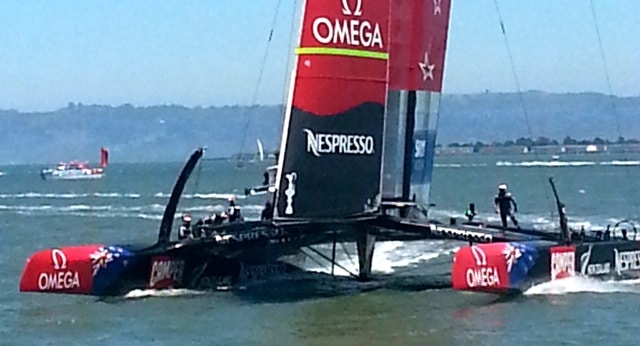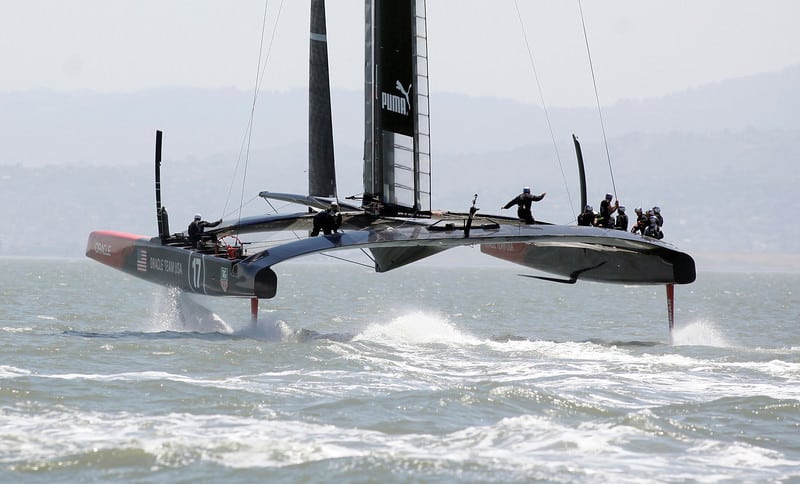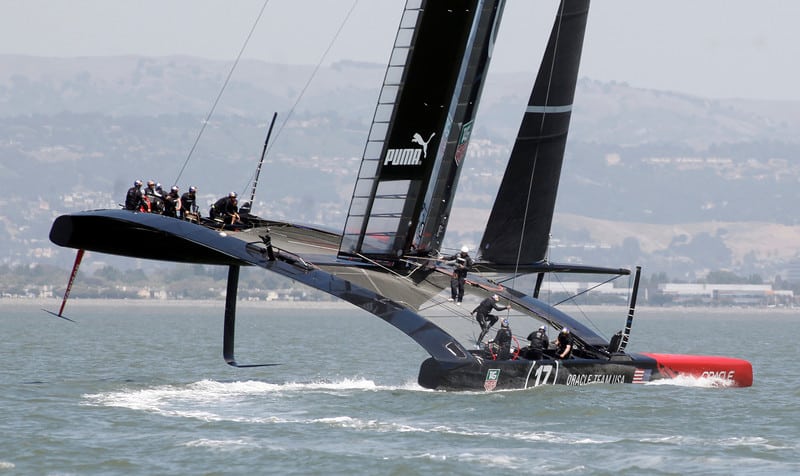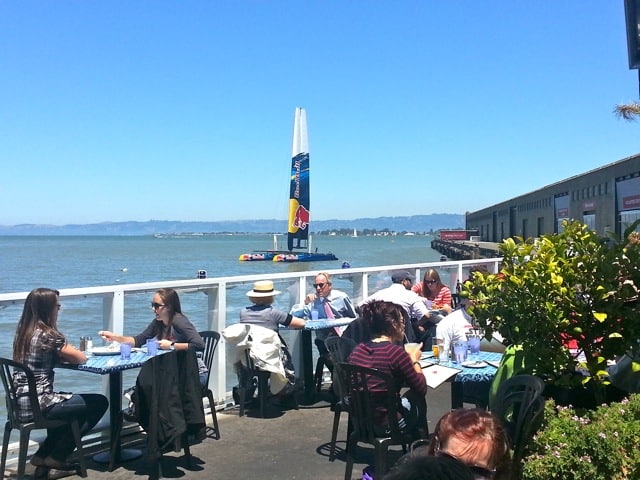Kiwis Sail Unopposed The Second Time Around!
 We excitedly made our trek into San Francisco by train from Pacifica to the America’s Cup Village to see the second race for the Louis Vuitton Cup elimination race between Emirates Team New Zealand and the Swedish Team Artemis, just to discover that Artemis was not ready to race yet! However, despite the lack of competition, it was a thrilling and beautiful day to be out watching the Kiwis put their boat through its paces and we had a prime spot, right at the finish line.
We excitedly made our trek into San Francisco by train from Pacifica to the America’s Cup Village to see the second race for the Louis Vuitton Cup elimination race between Emirates Team New Zealand and the Swedish Team Artemis, just to discover that Artemis was not ready to race yet! However, despite the lack of competition, it was a thrilling and beautiful day to be out watching the Kiwis put their boat through its paces and we had a prime spot, right at the finish line.
Once again, the Kiwis looked like a well oiled machine as they completed the 16.16 nautical mile course in 45 minutes, 28 seconds (about one minute faster than Sunday’s race) and achieved a top speed of 43.26 knots. The wind was slightly stronger, peaking at 20 knots as opposed to 16 knots on Sunday. With this “win”, Team New Zealand earned their second point of the Louis Vuitton Cup.
Artemis, having trashed their first boat in a training accident which claimed the life of British Olympic  medallist, Andrew Simpson, were sidelined for at least another week, while testing their second AC72. Artemis Racing put their second boat through its stress tests and are working it up into racing condition. Meanwhile regatta director Iain Murray sought to implement 37 new safety recommendations after this disaster. One included changes to the rudder specifications, which would mean altering the design rule just a week from the start of competition in the Louis Vuitton challenger series. Team New Zealand and Luna Rossa claim this will unfairly advantage Cup defenders Oracle. Luna Rossa and Team New Zealand are both awaiting the committes decision.
medallist, Andrew Simpson, were sidelined for at least another week, while testing their second AC72. Artemis Racing put their second boat through its stress tests and are working it up into racing condition. Meanwhile regatta director Iain Murray sought to implement 37 new safety recommendations after this disaster. One included changes to the rudder specifications, which would mean altering the design rule just a week from the start of competition in the Louis Vuitton challenger series. Team New Zealand and Luna Rossa claim this will unfairly advantage Cup defenders Oracle. Luna Rossa and Team New Zealand are both awaiting the committes decision.
 We were given an extra treat when the two Team Oracle boats sailed by us on a practice round just before Team New Zealand started the race. They looked very slick while practicing manuevers on the bay. One is skippered by Jimmy Spithill (Australian), who guided BMW Oracle Racing to victory in the last America’s Cup and he has been designated as Oracle’s skipper in the America’s Cup finals this year. The other is steered by Ben Ainslie (Brittish), who has won five Olympic gold medals and is a more recent entrant to multihull racing. Oracle team CEO Russell Coutts, is careful not to have the two teams risk catastrophic damage to either boats before the actual race and has to reign the teams in but we all hope that we will see a good match between the two at some point! (photo courtesy mercurynews.com)
We were given an extra treat when the two Team Oracle boats sailed by us on a practice round just before Team New Zealand started the race. They looked very slick while practicing manuevers on the bay. One is skippered by Jimmy Spithill (Australian), who guided BMW Oracle Racing to victory in the last America’s Cup and he has been designated as Oracle’s skipper in the America’s Cup finals this year. The other is steered by Ben Ainslie (Brittish), who has won five Olympic gold medals and is a more recent entrant to multihull racing. Oracle team CEO Russell Coutts, is careful not to have the two teams risk catastrophic damage to either boats before the actual race and has to reign the teams in but we all hope that we will see a good match between the two at some point! (photo courtesy mercurynews.com)
The transition to multihulls, the high-speed approach and cuting edge technology embraced by the Americas Cup Racing Teams has given the Cup a more adventurous edge and has earned the Americas Cup a place in the extreme sailing category alongside the Vendée Globe, the Route du Rhum and the Transat.  It has become the on water equivalent of F1 motor racing – fast, outrageously expensive, and dangerous. According to Regatta Director Iain Murray, a veteran himself of the 12 meter Americas Cup Race, speeds like what we’ve seen here even with very little wind, are unprecedented. New innovations like the 161 ft carbon fiber and kevlar fixed wing instead of a cloth sail and the inverted L carbon fiber foils that litterally makes the boat fly above the water, is but two of many dramatic changes to sailing for the Americas Cup. The AC72’ is a truly awesome piece of technology. (Photo courtesy mercurynews.com)
It has become the on water equivalent of F1 motor racing – fast, outrageously expensive, and dangerous. According to Regatta Director Iain Murray, a veteran himself of the 12 meter Americas Cup Race, speeds like what we’ve seen here even with very little wind, are unprecedented. New innovations like the 161 ft carbon fiber and kevlar fixed wing instead of a cloth sail and the inverted L carbon fiber foils that litterally makes the boat fly above the water, is but two of many dramatic changes to sailing for the Americas Cup. The AC72’ is a truly awesome piece of technology. (Photo courtesy mercurynews.com)

We finished off a perfect day at the races with a perfect plate of fish and chips at Pier 23 Cafe. The place looks like a hole in the wall at first blush but once inside, we were met by friendly staff, a sunny terrace with a perfect view of the Americas Cup Village, one of the Red Bull Youth America’s Cup boats bobbing on it’s mooring right outside their door, great live music and the best fish and chips that we have had in a while. I highly recommend it!
…and with that we bid San Francisco adieu and our best wishes to all the teams.





